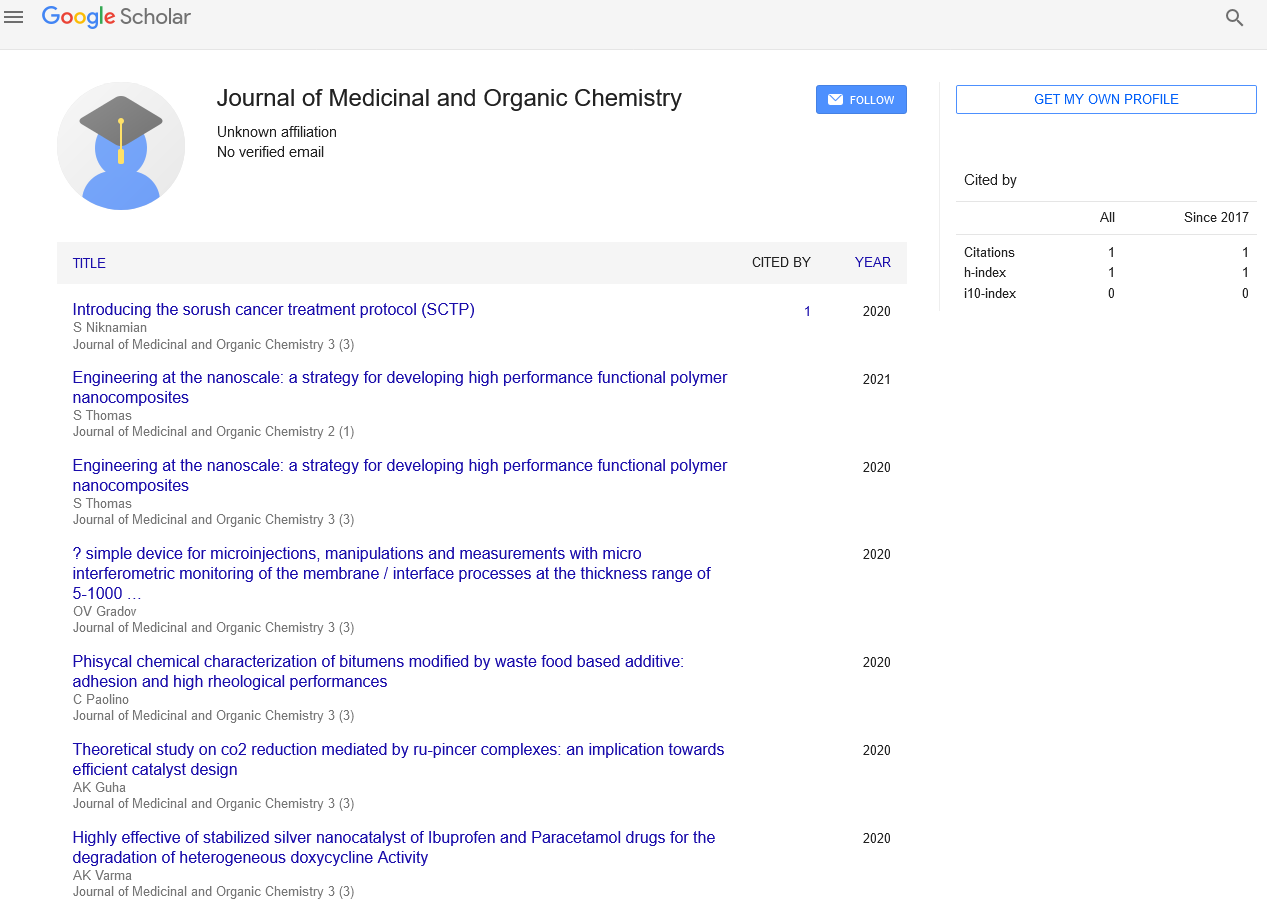Review Article - Journal of Medicinal and Organic Chemistry (2023) Volume 6, Issue 3
Revolutionizing Medicine: The Evolution of Drug Delivery Systems
Dr. Sahil Sharifi*
Department of Medicine and Pharmaceutics, University of LLP Science and technology, Pakistan
Department of Medicine and Pharmaceutics, University of LLP Science and technology, Pakistan
E-mail: sahil.s@gmail.com
Received: 02-June-2023, Manuscript No. jmoc-23-101948; Editor assigned: 05-June-2023, PreQC No. jmoc-23- 101948; Reviewed: 19-June-2023, QC No. jmoc-23-101948; Revised: 23- June-2023, Manuscript No. jmoc-23- 101948 (R); Published: 30-June-2023; DOI: 10.37532/jmoc.2023.6(3).68-71
Abstract
Drug delivery systems play a pivotal role in the efficient and targeted delivery of therapeutic agents to specific sites within the body. They have revolutionized the field of medicine by enhancing the efficacy, safety, and patient compliance of various drugs. This abstract provides an overview of drug delivery systems, highlighting their importance, challenges, and recent advancements. The abstract begins by introducing the concept of drug delivery systems and their significance in the context of personalized medicine. It discusses the limitations of conventional drug administration methods, such as oral and intravenous routes, and emphasizes the need for controlled and targeted drug delivery to improve therapeutic outcomes. The abstract then delves into the challenges associated with drug delivery, including poor bioavailability, limited tissue penetration, and systemic toxicity. Drug delivery systems have emerged as a critical component of modern medicine, enabling precise and controlled administration of therapeutic agents. They offer numerous advantages, including enhanced efficacy, reduced side effects, and improved patient compliance. Nanotechnology, biomaterials, and gene delivery are driving the development of innovative drug delivery systems. However, several challenges remain, necessitating ongoing research and collaborative efforts to overcome obstacles and fully exploit the potential of these systems for the benefit of patients worldwide.
Keywords
Drug delivery systems • Personalized medicine • Therapeutic agents • Efficacy • Safety • Patient compliance • Conventional drug administration • Controlled drug delivery • Targeted drug delivery • Bioavailability
Introduction
Advancements in drug delivery systems have transformed the field of medicine, enabling more targeted and efficient treatment options for various diseases. Over the years, researchers and scientists have developed innovative techniques and technologies to overcome the challenges associated with traditional drug delivery methods [1]. These advancements have revolutionized the way medications are administered, enhancing their effectiveness, reducing side effects, and improving patient outcomes. In this article, we will explore the evolution of drug delivery systems, the different types of systems available today, and their impact on healthcare. Drug delivery systems play a crucial role in the field of medicine by ensuring the efficient and targeted delivery of therapeutic agents to their intended sites of action within the body [2]. These systems are designed to overcome various challenges associated with conventional drug administration methods, such as poor bioavailability, limited drug stability, and non-specific distribution. By employing innovative technologies and strategies, drug delivery systems aim to enhance the therapeutic efficacy of drugs while minimizing their side effects [3].
Drug delivery systems play a crucial role in the field of medicine by facilitating the targeted and controlled release of therapeutic substances to specific sites within the body. These systems have revolutionized the way drugs are administered, improving their efficacy, safety, and patient compliance [4]. By optimizing the delivery of pharmaceutical compounds, drug delivery systems offer the potential to enhance treatment outcomes, minimize side effects, and enable personalized medicine. Traditional methods of drug administration, such as oral tablets or injections, often lack precision and may result in systemic distribution of the drug, leading to unintended side effects or inadequate therapeutic levels at the desired site [5]. In contrast, drug delivery systems provide a means to overcome these limitations, enabling the precise targeting of drugs to the affected tissues or cells while minimizing their exposure to healthy tissues. Various types of drug delivery systems have been developed, each designed to address specific challenges associated with drug administration. These systems can be classified into several categories, including micro- and nanoparticles, liposomes, implants, transdermal patches, and targeted drug delivery systems. Each system offers unique advantages in terms of drug stability, release kinetics, bioavailability, and sitespecific targeting [6].
Micro- and nanoparticles, for instance, can encapsulate drugs within biocompatible carriers, allowing controlled release and protection of the drug from degradation. Liposomes, on the other hand, are vesicles composed of lipid bilayers that can encapsulate both hydrophobic and hydrophilic drugs, offering improved solubility and stability. Implants, such as drug-eluting stents or subcutaneous devices, provide sustained release of drugs over extended periods, eliminating the need for frequent dosing. Transdermal patches offer a non-invasive method of drug delivery through the skin, bypassing the gastrointestinal tract and liver metabolism [7].
Targeted drug delivery systems employ various mechanisms to specifically deliver drugs to diseased tissues or cells. These systems can exploit factors such as specific cell surface receptors, pH gradients, or magnetic fields to enhance drug accumulation at the desired site while minimizing systemic exposure. The development of drug delivery systems requires a multidisciplinary approach, combining expertise from pharmaceutical sciences, material science, bioengineering, and medical research [8]. Scientists and researchers continually strive to innovate and refine these systems to improve drug efficacy, reduce toxicity, and enhance patient convenience.
The need for drug delivery systems
Traditional methods of drug administration, such as oral pills or injections, often present limitations that can hinder optimal treatment outcomes. For instance, orally administered drugs face challenges such as poor bioavailability, slow onset of action, and systemic toxicity. Invasive injections can cause pain, require trained healthcare professionals, and may have compliance issues [9]. These drawbacks led to the development of innovative drug delivery systems that aim to overcome these limitations and deliver drugs in a targeted and controlled manner.
Evolution of drug delivery systems
Controlled release systems: Controlled release systems allow for sustained and controlled drug release over an extended period. This approach ensures a constant therapeutic level of the drug in the body, reducing the frequency of administration and minimizing side effects. Examples of controlled release systems include transdermal patches, implantable devices, and microneedles.
Targeted drug delivery systems: Targeted drug delivery systems aim to deliver medications directly to the site of action, improving efficacy and reducing systemic side effects. These systems utilize various targeting strategies, such as ligand-receptor interactions, antibody-drug conjugates, or stimuli-responsive materials. Nanoparticles, liposomes, and hydrogels are among the promising platforms for targeted drug delivery.
Inhalation drug delivery systems: Inhalation drug delivery systems are particularly useful for treating respiratory conditions such as asthma, chronic obstructive pulmonary disease (COPD), and cystic fibrosis. Inhalers, nebulizers, and dry powder inhalers efficiently deliver medications to the lungs, ensuring rapid absorption and localized action.
Implantable drug delivery systems: Implantable drug delivery systems are designed to deliver drugs directly into specific tissues or organs. They often consist of biocompatible materials and can be programmable to release drugs at predetermined rates. Implantable pumps, stents, and microchips are examples of such systems. They are commonly used for longterm drug administration, such as hormone therapy or pain management.
Nanotechnology-based drug delivery systems: Nanotechnology has opened up new possibilities in drug delivery, allowing for precise targeting and controlled release. Nanoparticles can encapsulate drugs, protect them from degradation, and facilitate their transportation to specific cells or tissues [10]. This approach has shown great potential in cancer treatment, as nanoparticles can accumulate in tumors and deliver chemotherapeutic agents directly to cancer cells while minimizing damage to healthy tissues.
Advantages and impact on healthcare
The development of advanced drug delivery systems has revolutionized healthcare in numerous ways:
Improved drug efficacy: Targeted delivery systems ensure drugs reach their intended sites of action, enhancing their therapeutic efficacy. By minimizing systemic exposure, these systems can achieve higher drug concentrations at the target site, resulting in improved outcomes.
Reduced side effects: Drug delivery systems can significantly reduce the occurrence of systemic side effects associated with traditional drug administration methods. By concentrating drug action at the target site and minimizing exposure to healthy tissues, these systems enhance patient safety and tolerability.
Conclusion
Drug delivery systems are transforming the landscape of medicine by revolutionizing drug administration. These systems enable precise targeting, controlled release, and enhanced bioavailability of therapeutic substances, offering numerous benefits for patients and healthcare providers alike. As research continues to advance, we can expect further breakthroughs in drug delivery systems, leading to more effective and personalized treatments for a wide range of diseases.
Drug delivery systems play a crucial role in modern healthcare by enhancing the effectiveness, safety, and convenience of medication administration. These systems have evolved significantly over the years, with advancements in technology and innovative approaches. By carefully controlling the release, targeting, and distribution of drugs, drug delivery systems enable precise dosage regimens, minimize side effects, and improve patient compliance. The development of various drug delivery systems, such as nanoparticles, liposomes, implants, patches, and inhalers, has revolutionized the pharmaceutical industry. These systems offer unique advantages, including sustained release, localized drug delivery, improved bioavailability, and reduced dosing frequency. They have been instrumental in the treatment of a wide range of diseases, including cancer, diabetes, cardiovascular disorders, and neurological conditions.
Furthermore, drug delivery systems have opened new avenues for personalized medicine. They allow for tailored treatment approaches based on individual patient characteristics, such as genetic makeup, metabolism, and disease progression. This individualized approach improves therapeutic outcomes and minimizes adverse reactions, leading to improved patient outcomes and quality of life. Looking ahead, ongoing research and development in drug delivery systems hold immense promise. Advances in nanotechnology, biomaterials, and biotechnology are expected to further enhance the precision and efficiency of drug delivery. We can anticipate the emergence of innovative delivery mechanisms, such as smart implants, targeted gene therapy, and personalized 3D-printed dosage forms.
Drug delivery systems continue to shape the landscape of modern medicine, enabling optimized and individualized treatments. With continued advancements and interdisciplinary collaborations, these systems have the potential to revolutionize healthcare by offering safer, more effective, and patient-centric therapeutic options.
References
- Anderson JW, Ward K. High-carbohydrate, high-fiber diets for insulin-treated men with diabetes mellitus. Am J Clin Nutr. 32, 2312-2321 (1979).
- Booth FW, Chakravarthy MV. Physical activity and dietary intervention for chronic diseases, a quick fix after all. J Appl Physiol. 100, 1439-1440 (2006).
- Beccuti G, Monagheddu C, Evangelista A et al. Timing of food intake, Sounding the alarm about metabolic impairments? A systematic review. Pharmacological Research. 125, 132–141 (2017).
- Anderson JW, Ward K. High-carbohydrate, high-fiber diets for insulin-treated men with diabetes mellitus. Am J Clin Nutr. 32, 2312-2321 (1979).
- Booth FW, Chakravarthy MV Physical activity and dietary intervention for chronic diseases, a quick fix after all. J Appl Physiol. 100, 1439-40 (2006).
- Chandalia M, Lutjohann D, von Bergmann K et al. Beneficial effects of high dietary fiber intake in patients with type 2 diabetes mellitus. N Engl J Med. 342, 1392-8 (2000).
- Schwartz SE, Levine RA, Weinstock RS et al. Sustained pectin ingestion, effect on gastric emptying and glucose tolerance in non-insulin-dependent diabetic patients. Am. J. Clin. Nutr. 48, 1413-7 (1988).
- Reynolds A, Mann J, Cummings J et al. Carbohydrate quality and human health a series of systematic reviews and meta-analyses. Lancet. 393, 434-445 (2019).
- Simó R, Hernández C. Treatment of diabetes mellitus general goals, and clinical practice management. Revista Espanola de Cardiologia. 55, 845-860 (2002).
- Makam AN, Nguyen OK. An Evidence-Based Medicine Approach to Antihyperglycemic Therapy in Diabetes Mellitus to Overcome Overtreatment. Circulation. 135, 180-195 (2017).
Indexed at, Google Scholar, Crossref
Indexed at, Google Scholar, Crossref
Indexed at, Google Scholar, Crossref
Indexed at, Google Scholar, Crossref
Indexed at, Google Scholar, Crossref
Indexed at, Google Scholar, Crossref
Indexed at, Google Scholar, Crossref
Indexed at, Google Scholar, Crossref
Indexed at, Google Scholar, Crossref

